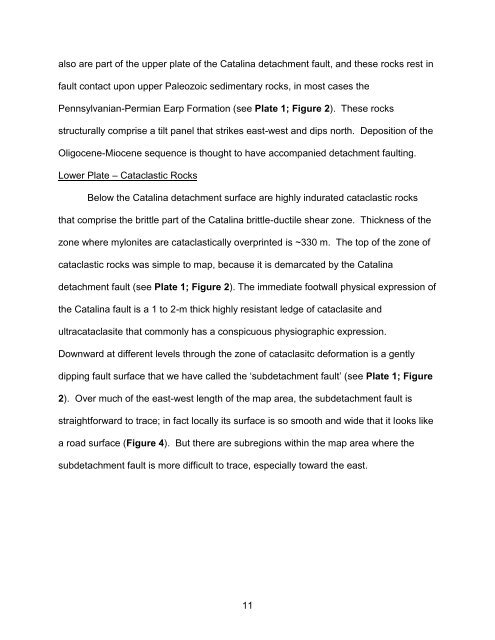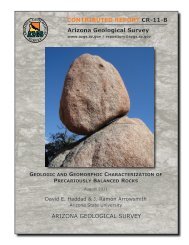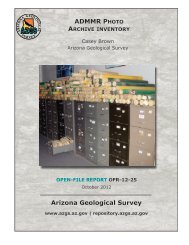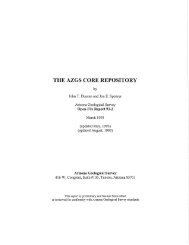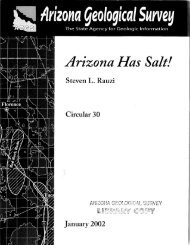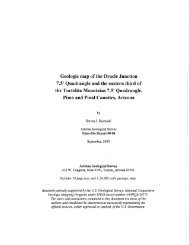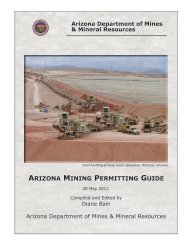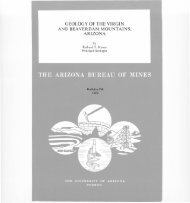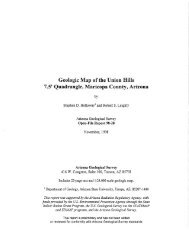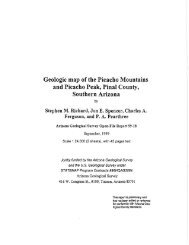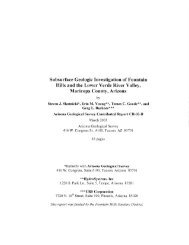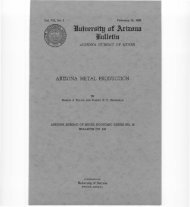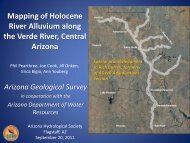Structural-Geologic Map Relationships in the Salcito Ranch Area,
Structural-Geologic Map Relationships in the Salcito Ranch Area,
Structural-Geologic Map Relationships in the Salcito Ranch Area,
Create successful ePaper yourself
Turn your PDF publications into a flip-book with our unique Google optimized e-Paper software.
also are part of <strong>the</strong> upper plate of <strong>the</strong> Catal<strong>in</strong>a detachment fault, and <strong>the</strong>se rocks rest <strong>in</strong><br />
fault contact upon upper Paleozoic sedimentary rocks, <strong>in</strong> most cases <strong>the</strong><br />
Pennsylvanian-Permian Earp Formation (see Plate 1; Figure 2). These rocks<br />
structurally comprise a tilt panel that strikes east-west and dips north. Deposition of <strong>the</strong><br />
Oligocene-Miocene sequence is thought to have accompanied detachment fault<strong>in</strong>g.<br />
Lower Plate – Cataclastic Rocks<br />
Below <strong>the</strong> Catal<strong>in</strong>a detachment surface are highly <strong>in</strong>durated cataclastic rocks<br />
that comprise <strong>the</strong> brittle part of <strong>the</strong> Catal<strong>in</strong>a brittle-ductile shear zone. Thickness of <strong>the</strong><br />
zone where mylonites are cataclastically overpr<strong>in</strong>ted is ~330 m. The top of <strong>the</strong> zone of<br />
cataclastic rocks was simple to map, because it is demarcated by <strong>the</strong> Catal<strong>in</strong>a<br />
detachment fault (see Plate 1; Figure 2). The immediate footwall physical expression of<br />
<strong>the</strong> Catal<strong>in</strong>a fault is a 1 to 2-m thick highly resistant ledge of cataclasite and<br />
ultracataclasite that commonly has a conspicuous physiographic expression.<br />
Downward at different levels through <strong>the</strong> zone of cataclasitc deformation is a gently<br />
dipp<strong>in</strong>g fault surface that we have called <strong>the</strong> „subdetachment fault‟ (see Plate 1; Figure<br />
2). Over much of <strong>the</strong> east-west length of <strong>the</strong> map area, <strong>the</strong> subdetachment fault is<br />
straightforward to trace; <strong>in</strong> fact locally its surface is so smooth and wide that it looks like<br />
a road surface (Figure 4). But <strong>the</strong>re are subregions with<strong>in</strong> <strong>the</strong> map area where <strong>the</strong><br />
subdetachment fault is more difficult to trace, especially toward <strong>the</strong> east.<br />
11


